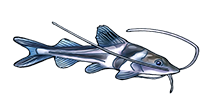| Scientific Name | Acestridium triplax Rodriguez & Reis, 2007 |
| Common Names | Emerald Whiptail Catfish Whiptail Catfish, Smaragdgrenmalle (Denmark) |
| Type Locality | Municipio de Juruti, igarapé Mutum, tributary to rio Aruã, a tributary to rio Branco, a tributary. to rio Aripiuns, itself a tributary to the lower rio Tapajós, 2°36'45''S, 56°11'37''W, Pará State, Brazil. |
| Etymology | The species epithet triplax from the Greek tri, three, and plax, plate, referring to the three series of abdominal plates. |
| Size | 56mm or 2.2" SL. Find near, nearer or same sized spp. |
| Identification | Acestridium was diagnosed by Schaefer (1991) based on the following characters: ten principal caudal-fin rays; plates at anterior snout margin forming conspicuous spatulate projection; head and body very slender, depressed; dorsal surface of head and trunk with longitudinal ridges; dorsal fin placed posteriorly, well beyond pelvic fin and just anterior to anal-fin origin; adipose fin absent; dermal plates anterior to first dorsal-fin proximal radial expanded, bearing ventromedial keel contacting the dorsal margin of the neural arches of the vertebrae six through twelve; and ridge of bone on the ventral surface of the lateral ethmoid contacting the metapterygoid channel reflected mesially. A. triplax can be distinguished from all its congeners by having one series of middle abdominal plates between the lateral abdominal plates (vs no abdominal plates between the lateral abdominal plates). |
| Sexing | Males of Acestridium triplax have conspicuous urogenital papilla, immediately posterior to anal opening, these are not present in females. |
| Distribution | South America: Rio Tapajós drainage, Amazon River basin in Brazil. Amazon, Lower Amazon, Tapajós (click on these areas to find other species found there) Login to view the map. |
| IUCN Red List Category | Least Concern , range map and more is available on the IUCN species page. Last assessed 2018. |
| Furniture | In the wild inhabits small forest creeks which are usually shallow (0.3-1.0 m deep, 5-10 m wide), with a sandy bottom, clear or slightly black water, moderate water current and dense aquatic and marginal vegetation. |
| Breeding | Unreported. |
| Breeding Reports | There is no breeding report. |
| Reference | Neotropical Ichthyology v. 5 (no. 4), pp 429, Figs. 1, 2A, 3A, 4A. |
| Registered Keepers | There is no registered keeper. |
| Wishlists | Love this species? Click the heart to add it to your wish list. There is but a single wish to keep this species, see who wants what. |
| Spotters | Spotted this species somewhere? Click the binoculars! There is but a single record of this fish being seen, view it. |
| Forum BBCode | |
| Search for A. triplax | |
| Look up A. triplax on AquaticRepublic.com | |
 | Look up A. triplax on Fishbase |
 | Look up A. triplax on Encyclopedia of Life |
 | Look up A. triplax on Global Biodiversity Information Facility |
| LFS label creator ARN ref:1.4.197.2495 | |
| Last Update | 2025 Jan 01 12:13 (species record created: 2010 Jul 04 04:58) |





/siluriformes/loricariidae/acestridium/triplax/1.jpg)
/siluriformes/loricariidae/acestridium/triplax/2.jpg)
/siluriformes/loricariidae/acestridium/triplax/3.jpg)
/siluriformes/loricariidae/acestridium/triplax/4.jpg)
/siluriformes/loricariidae/acestridium/triplax/5.jpg)
/siluriformes/loricariidae/acestridium/triplax/6.jpg)
/siluriformes/loricariidae/acestridium/triplax/7.jpg)
/siluriformes/loricariidae/acestridium/triplax/8.jpg)
/siluriformes/loricariidae/acestridium/triplax/9.jpg)
/siluriformes/loricariidae/acestridium/triplax/10.jpg)
/siluriformes/loricariidae/acestridium/triplax/11.jpg)
/siluriformes/loricariidae/acestridium/triplax/12.jpg)
/siluriformes/loricariidae/acestridium/triplax/13.jpg)